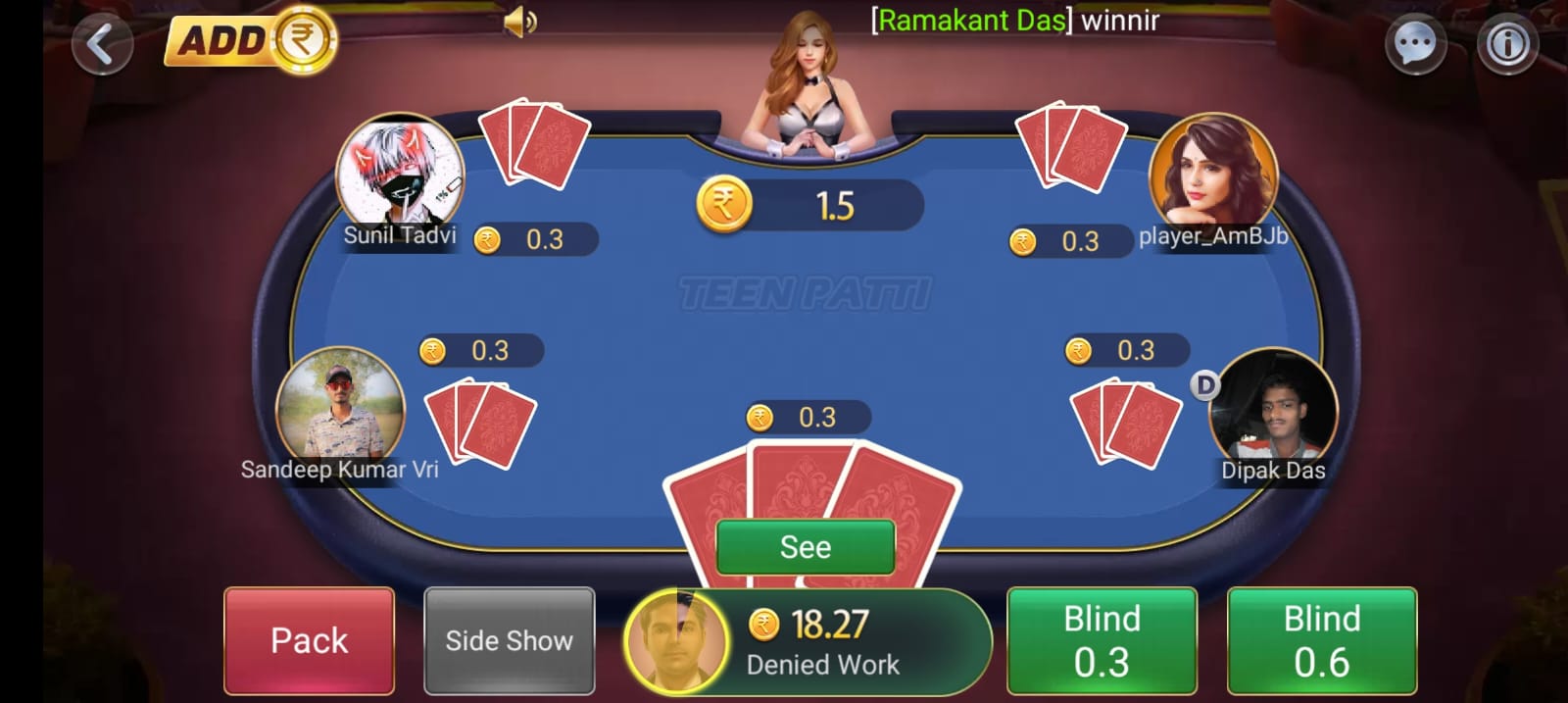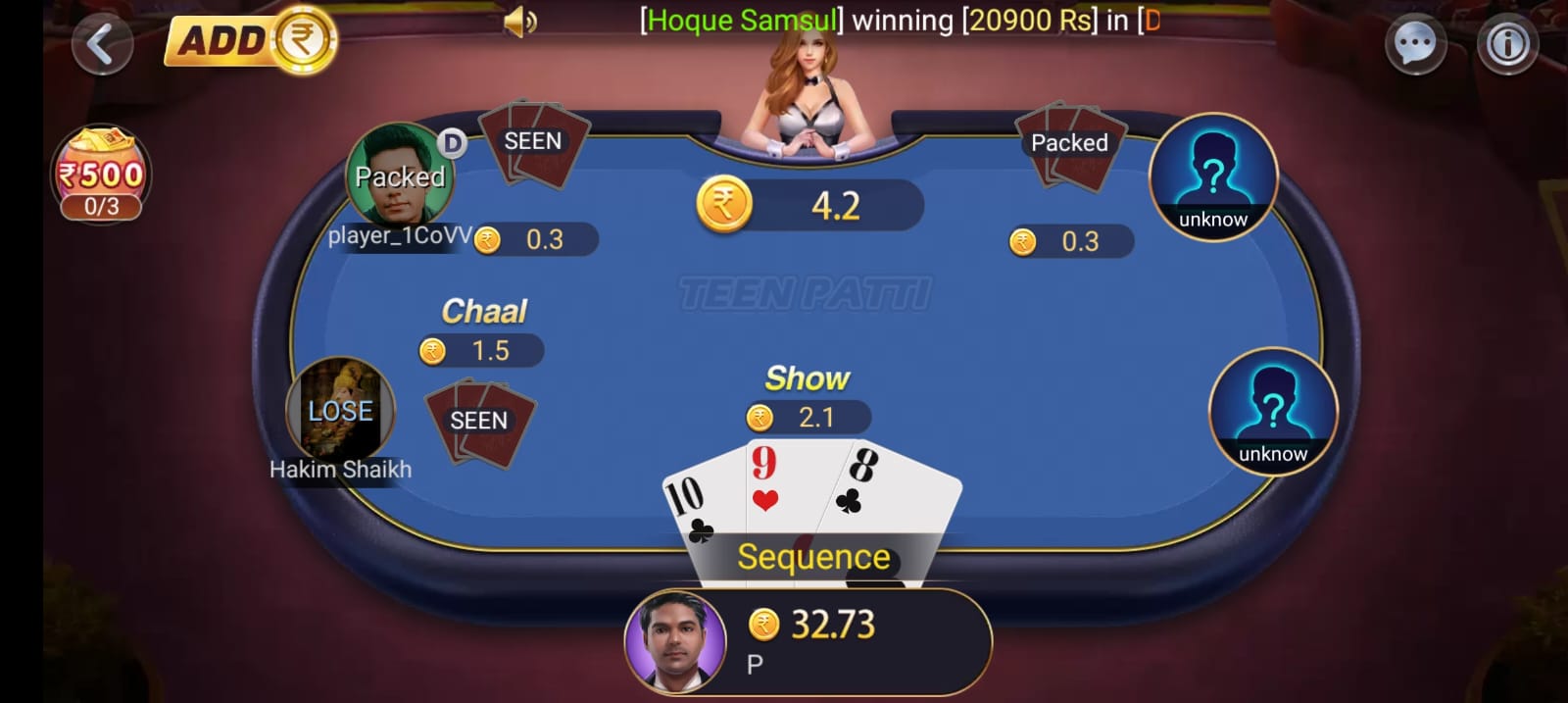Master Teen Patti with winning strategies. Learn tactics like small bets, blind play, opponent analysis, bluffing, and bankroll management to dominate Teen Patti Master.
Introduction
Teen Patti Master, a popular card game rooted in Indian culture, combines skill, strategy, and a bit of luck. Whether you’re a seasoned player or a newcomer, mastering Teen Patti requires understanding its nuances and implementing effective strategies. This guide delves into masterful winning strategies to help you dominate the Teen Patti Master table. From initiating small bets to employing sideshows effectively, we cover all aspects to enhance your gameplay.
Dominate the Teen Patti Master Table: Masterful Winning Strategies
Strategy Overview
Understanding and implementing a variety of strategies can significantly improve your Teen Patti Master gameplay. This section provides a comprehensive overview of essential tactics.
Commencing with Small Stakes
Starting with small stakes in Teen Patti is a strategic move that serves several purposes:
- Set Betting Limits: Decide on a reasonable starting bet that’s a small percentage of your bankroll to minimize risk.
- Advantage of Blind Play: Initiate the game by playing blind to keep your initial bets low and gather information about your opponents’ strategies.
- Discipline in Betting: Maintain your small bet strategy consistently, regardless of the betting behavior of others.
- Incremental Raises: If you choose to raise, do so gradually to avoid inflating the pot size unnecessarily.
- Adjust as Needed: Be prepared to slightly adjust your bet size as your stack grows or as the table dynamics change, while still keeping the bets modest.
- Pot Management: Focus on controlling the pot size to avoid overcommitting to weaker hands.
Starting small allows for longer play time, enabling you to learn and adapt without risking too much of your bankroll early on.
The Art of Blind Play
Playing blind in Teen Patti ups the ante with risk and psychological tactics:
- Lower Bets: Blind bets are smaller, giving you a cost-effective edge.
- Intimidation Factor: Your boldness can pressure opponents, causing them to second-guess their stronger hands.
- Game Pace: It keeps early stakes low and may deter aggressive raises from those who’ve seen their cards.
- Switching to Seen: You can choose to view your cards at any turn, moving to a seen player’s betting level.
- No Sideshow: Blind players can’t request sideshows, an option only for seen players.
- Winning the Pot: If you’re the last standing in a blind play, or upon a showdown after revealing your cards, you could take the pot.
Blind play is a strategic move that combines courage with cunning, controlling both the pot and the game’s psychological dimension.
Deciphering Opponent Behavior
In Teen Patti, as in poker, interpreting the subtleties of your opponents’ actions can be as crucial as playing your cards right. Here’s a breakdown on how to decode their behavior:
- Betting Patterns: Keep an eye on how opponents bet. Regular high bets could suggest strong hands or a bluffing risk-taker, while consistent low bets may hint at weaker hands.
- Physical Tells: Be alert to body language or facial expressions. Nervous fidgets, fleeting looks at chips or cards, or shifts in posture can reveal confidence levels.
- Reactions to Bets: Observe the response to others’ bets. Immediate folds, confident calls, or bold raises can shed light on hand strength and strategy.
- Playing Style: Figure out their approach – aggressive, cautious, or erratic. Aggressive players might bluff often; cautious ones likely bet high only with strong hands.
- Table Talk: Listen to the chatter. Some use talk as a weapon to distract or deceive. Their words can often be a window into their confidence with their hand.
Reading these cues offers insights into your rivals’ hands and strategies, guiding your moves and potentially steering you toward victory.
Bluffing with Finesse
Mastering the art of bluffing in Teen Patti can tip the scales in your favor, compelling adversaries to back down from a weaker hand. Here’s how to bluff with skill:
- Confidence Display: Bet with conviction. Quick and firm betting may convey a strong hand, while wavering can betray doubt.
- Strategic Timing: Identify optimal bluffing moments, especially when you’ve played consistently and haven’t been caught bluffing recently.
- Calculated Betting: Escalate your bets progressively or make a bold move when it feels right, but avoid erratic betting which can prompt suspicion.
- Solid Reputation: If you’re known for playing tight and bluffing seldom, your bets are more likely to be taken seriously.
- Target Selection: Bluff against players prone to folding under pressure, steering clear of frequent callers.
- Positional Advantage: Utilize late positions at the table to capitalize on the betting information available from other players’ actions.
- Manageable Pot: Aim to bluff when the pot is small, as players are less inclined to call due to lower stakes.
- Bluff Sparingly: Overuse dilutes a bluff’s potency. Bluff judiciously so players remain uncertain of your true intentions.
Bluffing is a subtle dance of misdirection and boldness, best performed with a keen sense of judgment and the perfect opportunity. Use it sparingly for maximum impact.
Prudent Bankroll Management
Navigating the financial currents of Teen Patti demands a strategic approach to your chip stack. Here’s your guide to prudent bankroll management:
- Set Financial Boundaries: Before diving into play, define your risk threshold. Commit to a limit that fits your budget and resolve to adhere to it.
- Smart Buy-ins: Enter games with just a slice of your bankroll, typically no more than 5-10%, to avoid depleting your funds in one swoop.
- Reflective Betting: Tailor your wagers to the size of your bankroll. A modest stack calls for smaller bets, extending your playtime and enjoyment.
- Steer Clear of Tilt: A losing streak? Step away. Emotional play invites rash decisions, so pause and reset when needed.
- Target Profits: Set a realistic profit target for your session. Hitting it? It might be time to step back and secure your gains.
- Keep Records: Document every win and loss. This habit isn’t just about accountability; it’s a tool to refine your approach.
- Stakes Adjustment: If a losing trend emerges, consider dropping to a lower-stakes game to minimize the impact on your bankroll.
- Disciplined Play: Resist the urge to chase losses. Stay aligned with your bankroll management strategy to avoid impulsive and potentially damaging bets.
By applying these principles, you’re not just playing Teen Patti; you’re playing the long game, ensuring your stakes are sustainable and your chip stack remains healthy.
Strategic Folding
Mastering the fold is key in Teen Patti, protecting your chips for the right moments. Here’s a concise guide:
- Weak Hands: Fold early if improvement seems unlikely.
- High Bets: If bets escalate and your hand is weak, consider folding.
- Reading Opponents: Aggressive betting often means strength; fold if you can’t compete.
- Positional Play: In early positions with poor hands and heavy action, folding is wise.
- Bankroll First: Protect your bankroll—if the bet is too risky, folding is sensible.
- Table Dynamics: Tight players betting big usually have strong hands; fold yours if it’s weaker.
- Chasing Warning: Fold instead of chasing unlikely cards to improve your hand.
- Bet Attachment: Let go of sunk costs in bets; better to fold than lose more.
- Big Picture: Focus on the long-term game, where strategic folding is often a winning move.
Folding is strategic, not defeatist, keeping you in the game to win another round.
Optimal Timing for Seen Play
Selecting when to play “Seen” in Teen Patti hinges on a few strategic considerations:
- High Pot: Play seen if the pot justifies the extra cost.
- Aggressive Opponents: If others are playing seen and betting strong, consider doing the same for informed decisions.
- Bankroll Check: Ensure you can afford the seen play, which doubles the bet.
- Positional Advantage: Use a late position to decide on playing seen after observing others.
- Duration of Blind Play: If you’ve been playing blind for several rounds, it may be time to play seen.
- Opponent Behavior: Play seen if you detect weakness in other seen players to gain an edge.
- Game Tightness: In a cautious game with strong hands, playing seen can be essential.
- Pot Odds: Play seen when the payout is worth the extra bet.
Use seen play strategically, considering both your hand’s potential and the game’s dynamics.
Employing Sideshows Effectively
Here’s a quick guide to using sideshows in Teen Patti:
- Eligibility: Request a sideshow only when both you and the previous bettor have seen your cards and after a new bet is made.
- How to Request: Simply say “sideshow” or signal discreetly if playing in person.
- Consent: The challenged player can accept to compare hands or decline, forcing you to act.
- Outcome: If accepted, compare hands in private; the weaker hand folds, or the requester folds in a tie.
- Keep it Private: Don’t reveal your hand to others during the comparison.
- Game Continues: After the sideshow, the game moves on with the next player.
- Limitations: Be aware of any game rules on the number or cost of sideshows.
- Strategic Use: Employ sideshows to gauge opponents’ hands without a large bet.
Sideshows are a strategic tool to use judiciously, helping you make informed decisions without significantly raising the stakes.
Calculating Pot Odds for Betting
Understanding pot odds in Teen Patti is crucial for making sound betting decisions. Here’s how to factor them into your gameplay:
- Determine Pot Odds: Compare the call amount to the total pot size. Use the formula: Pot Odds = Current Pot Size / Amount to Call.
- Evaluate Hand Strength: Judge if your hand is likely to win—categorize it as strong, average, or weak.
- Hand Odds Versus Pot Odds: Though precise hand odds are elusive in Teen Patti, intuitively estimate them. If your estimated chance of winning seems higher than the pot odds, calling might be favorable.
- Decision Time: Call if the pot odds exceed your estimated hand odds. Otherwise, consider folding.
For instance, with a $100 pot and a $10 call, your pot odds are 10:1. If your hand’s win chance feels better than 10:1, calling is a good move.
Pot odds in Teen Patti are more about balancing risk and potential gain rather than exact math. This concept helps guide when to call, fold, or raise.
Adaptability During Game play
Being adaptable in Teen Patti is essential, as it demands constant strategy adjustments in response to the evolving game conditions and player behaviors. Here’s how you can stay flexible:
- Strategy Shift: Be ready to alter your game plan if it’s not yielding results. For instance, pivot from aggressive to conservative tactics if you’re facing frequent challenges.
- Observing Opponents: Pay close attention to betting patterns and physical cues of your rivals. Adapt by exploiting tendencies, like calling against habitual bluffers.
- Variance Management: Teen Patti can be unpredictable. Stay composed and adapt bets to the flow of the game, instead of making rash decisions.
- Bankroll Flexibility: Adjust your stakes in response to the game’s ups and downs. If losses stack up, reduce your bets or take a breather.
- Dynamic Play: Each table has its own rhythm. Adapt by playing more open or tight, depending on the current table dynamic.
- Progressive Adjustments: As blinds and antes rise, modify your strategy for the increased stakes.
Adaptability in Teen Patti involves a fluid approach, molding your tactics to the specifics of the game, discerning your opponents’ strategies, and evaluating the strength of your hand as the game unfolds.
Conclusion
To master Teen Patti, it’s crucial for a player to understand the intricacies of the game, skillfully interpret the actions of their adversaries, judiciously handle their funds, and strike a balance between aggressive and cautious play. Consistent practice, flexible adjustment to different game scenarios, and smart utilization of available bonuses are key ingredients to a player’s triumph. Integrating these tactics with sharp observation skills and mental steadiness can significantly elevate a player’s prowess in this widely enjoyed card game.
FAQ
What is the best starting bet in Teen Patti Master?
The best starting bet in Teen Patti Master is a small percentage of your bankroll, typically around 5-10%, to minimize risk and gather information about your opponents’ strategies.
How can I effectively use bluffing in Teen Patti?
Effective bluffing in Teen Patti involves betting with confidence, choosing strategic moments, and progressively escalating bets while maintaining a solid reputation for playing tight and bluffing seldom.
What should I consider when deciding to play seen?
Consider the pot size, opponent behavior, your bankroll, positional advantage, and the duration of blind play when deciding to play seen.
How can I read my opponents’ behavior in Teen Patti?
Read opponents’ behavior by observing their betting patterns, physical tells, reactions to bets, playing styles, and table talk.
What is the importance of bankroll management in Teen Patti?
Bankroll management ensures you play sustainably, avoid emotional decisions during losing streaks, and extend your playtime by setting financial boundaries and smart buy-ins.
How can I calculate pot odds in Teen Patti?
Calculate pot odds by comparing the call amount to the total pot size and intuitively estimating your hand’s likelihood of winning. If the estimated chance of winning is higher than the pot odds, calling may be favorable.





